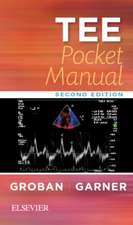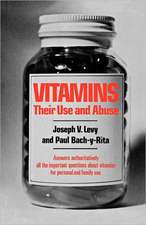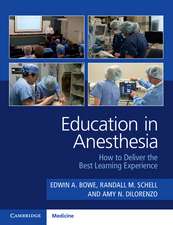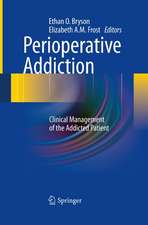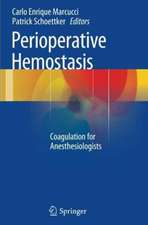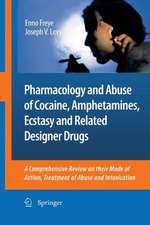Opioids in Medicine: A Comprehensive Review on the Mode of Action and the Use of Analgesics in Different Clinical Pain States
Autor Enno Freye Joseph V. Levyen Limba Engleză Paperback – 19 oct 2010
| Toate formatele și edițiile | Preț | Express |
|---|---|---|
| Paperback (1) | 1612.02 lei 6-8 săpt. | |
| SPRINGER NETHERLANDS – 19 oct 2010 | 1612.02 lei 6-8 săpt. | |
| Hardback (1) | 935.32 lei 3-5 săpt. | +40.94 lei 10-14 zile |
| SPRINGER NETHERLANDS – apr 2008 | 935.32 lei 3-5 săpt. | +40.94 lei 10-14 zile |
Preț: 1612.02 lei
Preț vechi: 1696.86 lei
-5% Nou
Puncte Express: 2418
Preț estimativ în valută:
308.45€ • 322.92$ • 255.23£
308.45€ • 322.92$ • 255.23£
Carte tipărită la comandă
Livrare economică 05-19 aprilie
Preluare comenzi: 021 569.72.76
Specificații
ISBN-13: 9789048174867
ISBN-10: 9048174864
Pagini: 488
Ilustrații: XII, 472 p.
Dimensiuni: 155 x 235 x 26 mm
Greutate: 0.74 kg
Ediția:Softcover reprint of hardcover 1st ed. 2008
Editura: SPRINGER NETHERLANDS
Colecția Springer
Locul publicării:Dordrecht, Netherlands
ISBN-10: 9048174864
Pagini: 488
Ilustrații: XII, 472 p.
Dimensiuni: 155 x 235 x 26 mm
Greutate: 0.74 kg
Ediția:Softcover reprint of hardcover 1st ed. 2008
Editura: SPRINGER NETHERLANDS
Colecția Springer
Locul publicării:Dordrecht, Netherlands
Public țintă
Professional/practitionerCuprins
Introduction. Part I Rational for the Use of Opioids in Nociceptive Transmission. The Nociceptive System, an Elementary Part of the Body’s Protective Scheme. Acute Pain – Sequence of Changes in the Body. Differences in Pain Quality. Anatomy of Pain and Analgesia. Significance of C-Fibers in Pain Transmission. Significance of Aß-Fibers in Pain Modulation. Transmission of Pain with Different Qualities. Substance P, a Mediator of Pain and a Member of the Tachykinine Family. Supraspinal Processing of Pain. Transduction of Nociception Via the Spinothalamic Tracts. The Descending Antinociceptive System. Neurophysiology of Pain – Type of Receptor Sites Involved in Therapy. Transduction of Nociceptive Afferences Via Ascending Pathways. Different Therapeutic Approaches in Pain Therapy. Significance of Bradykinins in Inflammatory Pain. Cox Inhibitors in the Alleviation of Pain. The Opioid Receptor System – Main Target in Pain Therapy. Inhibitory and Excitatory Effects of Nociception at the Spinal Cord Level. Neurohormones In Transmission of Nociception. Melanocortins. Cholecystokinins. Calcitonin-Gene-Related Neuropeptide. Galanin. Nitric Monoxide, Mediator for Chronic Pain. The Cannabinoid System. Ion Channel Modulators Resulting in Facilitation/Inhibition of Nociception. The P2X and P2Y Receptor System. The Vanilloid Receptor System. Voltage-Gated Sodium Channels as Ion Conduit Modulators. Non Voltage-Gated Potassium Channels. Ionotropic Glutamate Receptor Ion Channel Modulators. Excitatory Glutamate Receptor; Mediator of Pronociceptive Effects. The Nicotinic/Acetylcholine (NAchR) Receptors. Nerve Growth Factor (NGF) in Mediating Hyperalgesia. Significance of the Immune System and Microglia in Chronic Pain. Reflectory, Segmental Mediation of Pain Afferents. Sequence of Resulting in Neuropathic Pain. Causes of Potentiation and Transition From Acute to Chronic Pain. Neurophysiological Changes Taking Effect During Evolution of Pain. Supraspinal Engrams Relevant inTransition from Acute to Chronic Pain. Preventing Transition from Acute to Chronic Pain – Use of Analgesics with Different pharmacology. Rationale for the Use of Opioids. Reasons for Insufficient Opioid use – The 11 Myths in Opioid Therapy. Alternative Therapeutic Targets in Pain Therapy. Proton Channels as Therapeutic Targets in Pain Therapy. Adjuvant Analgesics in Pain Therapy. Difference in Receptor Activation/Inhibition as Drug Targets. Mechanism of Action of Tricyclic Antidepressants. Pharmacologically Resistant – Psychologically Conditioned Pain. The Malingering Patient with Compensatory Pain Behavior. References. Part II Mechanism of Action of Opioids and Clinical Effects. Conversion of Morphine to Heroin (Diacetylmorphine). Major Classes of Opioid Analgesics in Clinical Practice. Mode of Action of Opiates/Opioids. Overview of the Different Opioid Receptors and their Subtypes. Agonists, Antagonists, their Potency and Mode of Action. Relative Potency and Equianalgesic Doses. Specific Binding Sites for Opioids in the CNS. Reasons for Difference in Potency of Opioids. Intracellular Signaling Following Opioid Binding. G-Protein Coupled Receptors and the Adenylate Cyclase Signaling System, Mediators of Opioid Action. Significance of the Heterotrimeric G-Proteins in Intracellular Transmission. Differences in Clinical Effects of Various Opioids. Opioid-Refractory Painful Conditions. Opioid-Related Side Effects. Opioid-Induced Respiratory Depression. Significance of the Different Opioid Receptors in the Mediation of Respiratory Depression. Vigilance, Leading Parameter in Opioid-Related Respiratory Depression. Reasons for Prolongation of Opioid-Related Respiratory Depression in Patients. Difference in Sedative-Hypnotic Effect of Opioids. Difference in the Hypnosedative and Analgesic Effect of Potent Opioids. Potential Epileptogenic Potency of Opioids. The Antitussive Action of Opioids (Blockade of Cough Reflex). Dependence Liability of Opioids –Pharmacological Principles of Addiction. Neurobiological Changes with Addiction. Opioids Inducing Nausea and Emesis. Opioids and Muscular Rigidity. The Pupillary Effect of Opioids. Opioids and Gastrointestinal Inhibition (Constipation). Clinical Relevance of Opioid-Induced Constipation. Opioids and the Cardiovascular System. References. Part III Opioids, an Integrative Part in Perioperative Medicine. Intraoperative Use of Opioids for Anesthesia. Potentiation of Opioid-Based Anesthesia. Pharmacokinetics of Opioids: Significance for Clinical Use in Anesthesia. Significance of Pharmacokinetic Data for Practical Use. Advantages of "Maintenance Phase" Infusions Compared to Intermittent Bolus Dose. Use of Target Controlled Infusion (TCI) Systems in Anesthesia. "On-Top"-Dose of Either Alfentanil or Remifentanil in an Opioid-Based Anesthetic Regimen. Recommendations for the Use of Remifentanil. The Pharmacology of Sufentanil. Respiratory Depression After Sufentanil. The Hypnosedative Effect of Sufentanil. Sufentanil and Muscular Rigidity. Sufentanil in Selective Operations. Neurosurgery. Sufentanil in Open-Heart Surgery. Interaction of Sufentanil. Volatile Aspects. Muscle Relaxants. Barbiturates. Practical Considerations for the Use of Sufentanil. Examples for the Use of Sufentanil in Anesthesia. Opioids for Use in Postoperative Pain Management. Addiction Liability by Use of Opioids for Postoperative Pain. Time-Contingent Dosing of Opioids for Postoperative Pain. Selection of the Appropriate Agent in Postoperative Pain Management. Choice of Opioid Agents for Post-Operative Pain Treatment. Dosage of Opioid Analgesics in Post-Operative Pain Treatment. Implications of Agonist/Antagonists in Postoperative Pain Management. Patient-Controlled Analgesia (PCA) for Postoperative Pain Therapy. Opioids On-Demand, Without Use of a PCA System. New Techniques for Postoperative Pain Management. Selective Opioid Antagonists for Postoperative Reversal of Opioid Side Effects. PostoperativeOpioids – Summary and Outlook. Neuraxial Administration of Opioids for Pain Therapy. Side Effects of Epidural Opioids. Lipophilic or Hydrophilic Opioids for Neuraxial Use. Extended-Release Epidural Morphine for Postoperative Pain. Combination of an Epidural Opioid with a Local Anesthetic. Continuous-Infusion Epidural Analgesia (CIEA). Intrathecal Use of Opioids. Mixed Agonist/Antagonists and _2-Agonists for Neuraxial Use. References. Part IV Use of Potent Opioids for Chronic Pain Management. Long-Term Management of Chronic Pain. Defining the Different Type of Opioids. Agonists. Antagonists. Mixed Agonist–Antagonists. The WHO Guidelines for Pain Therapy. Dosing of Opioids in Tumor Pain. Co-Analgesics (Adjuvants) for Long-Term Pain Therapy with Opioids. Buprenorphine – Opioid with Unique Receptor Kinetics for Chronic Pain. Transdermal Patches for Use in Chronic Pain – Fentanyl TTS and Buprenorphine TDS. Rational for the Use of Transdermal Systems. Pharmacokinetics of Opioids Used in Transdermal Systems. Specificity of Transdermal Buprenorphine. Oral Transmucosal Fentanyl Citrate (OTFC) Stick for Treatment of Breakthrough Pain. Differences in Transdermal Technology and Pharmacology of Fentanyl and Buprenorphine. Change from Oral Morphine to a Transdermal Opioid. Rotation from Oral Morphine to Transdermal Buprenorphine. Commonly Observed Side-Effects in Long-Term Pain Treatment with Opioids. Respiratory Depression. Development of Dependency in Chronic Opioid Use. Development of Tolerance During Long-Term Use of Opioids. Constipation, a Common Side Effect of Opioids. Nausea and Vomiting. Marked Sedation. Pruritus. Rotation from One Opioid to Another. Opioid Rotation from Morphine to Buprenorphine or Methadone. Oxycodone and Hydromorphone – Alternative Opioids for Pain Relief. Use of Opioids in Non-malignant Pain. Driving Ability While Taking an Opioid for Pain Relief. New Options in Opioid Medication – The OROS® (Oral Osmotic Pump) System. Oxytrex™Ultra-Low Dose Opioid Antagonist Combined with Oxycodone with Less Tolerance Development. Remoxy™ with ORADUR Technology, Opioid with an Abuse-Resistant Formulation. Combining Oxycodone with the Opioid Antagonist Naloxone to Deter from Drug Abuse. Delivery of Opioids via the Lungs – The Aerosolized Liposome- Encapsulated Fentanyl (AeroLEF™). AERx® Pulmonary Delivery System for Morphine and Fentanyl. DUROS® Implant Technology for Chronic Pain Treatment. Transdur™ Sufentanil Technology with 1 Week of Opioid Release. Effervescent Buccal Fentanyl Tablet for Treatment of Breakthrough Pain. Intrathecal DUROS® Opioid Delivery Using a Precision Miniature Catheter. Appendices: Duration of Action and Dosing of Opioid Analgesics. References. Part V Detection of Illicit Use of Opioids in Primary Care. Introduction. Physical Dependency. Definitions and Concepts in Physical Dependency. Terminology in Illicit Use of Opioids. Bioavailability of Pain Medicine Related to Abuse. Avoiding Abuse Liability When Prescribing Opioids. Avoiding Illicit Use by Ongoing Assessment and Documentation. Typical Drug Scams to Obtain a Prescription Opioid. Prescribing Opioids – The Controlled Substances Act from 1979. Typical Patterns as Predictive Signs of Aberrant Drug-Related Behavior. Avoiding Drug Diversion from Medical to Illicit Use. Avoiding Illicit Use by Combining Opioids with Antidepressants/Antiepileptics. Demask the Patient Prone to Develop Illicit Use. Further Stigma of Persons with a Potential Drug Addictive Behavior Pattern. The Alcohol Addictive Patient. The Most Common Signs of Alcohol Addiction. Concomitant Sequelae of Alcoholism. Common Comprehensions on Prescription Drug Abuse. Physical Signs and Symptoms of Hard Drug Abuse. The Red Flags During Initial Assessment. Use of Urine Drug Screening (UDS). Summary of Considerations When Using Urine Drug Screening (UDS). Indications for Random Urine Drug Testing. Types of Urine Drug Testing. Summary When Using Urine DrugTesting (UDT). Interpretation of UDT Results. Limitations of Urine Drug Testing (UDT). Half-Life of Detection and Cut-Offs in Urine Drug Screening. Interpretation of Results. Pitfalls with Urine-Drug-Testing (UDT). Summary of Considerations When Having a Positive Urine Test. Test Procedure When Using a Multi-Test Card. Confirmation Analysis of Quick Tests. Assessing Possible Manipulation of the Urine Sample. Screening for Alcohol Abuse. Hair or Saliva for Drug Testing. Hair Analysis for the Detection of Abused Drugs and Medications. References. Index.
Recenzii
From the reviews:
"This review of the pharmacology and clinical uses of opioids provides an overview of pain anatomy and physiology and … how to treat different painful conditions with narcotics. … The book is intended for any physician who treats patients with acute or chronic pain, making it appropriate for pain specialists and primary care physicians. However, any surgeon or physician … would find this book helpful. … This is an excellent addition to the field of pain medicine, bridging the gap between pharmacology and practice." (Tariq M. Malik, Doody’s Review Service, June, 2008)
"This review of the pharmacology and clinical uses of opioids provides an overview of pain anatomy and physiology and … how to treat different painful conditions with narcotics. … The book is intended for any physician who treats patients with acute or chronic pain, making it appropriate for pain specialists and primary care physicians. However, any surgeon or physician … would find this book helpful. … This is an excellent addition to the field of pain medicine, bridging the gap between pharmacology and practice." (Tariq M. Malik, Doody’s Review Service, June, 2008)
Caracteristici
Stressing key concepts and essential information on pain and its treatment Providing one-step review of the important concepts in the mode of action of opioids Summary of symptoms and modalities available for treatment of major pain syndromes Written for everyone who needs detailed information on practical use on opioid pharmacology Broad review for everyone preparing for the board examination





